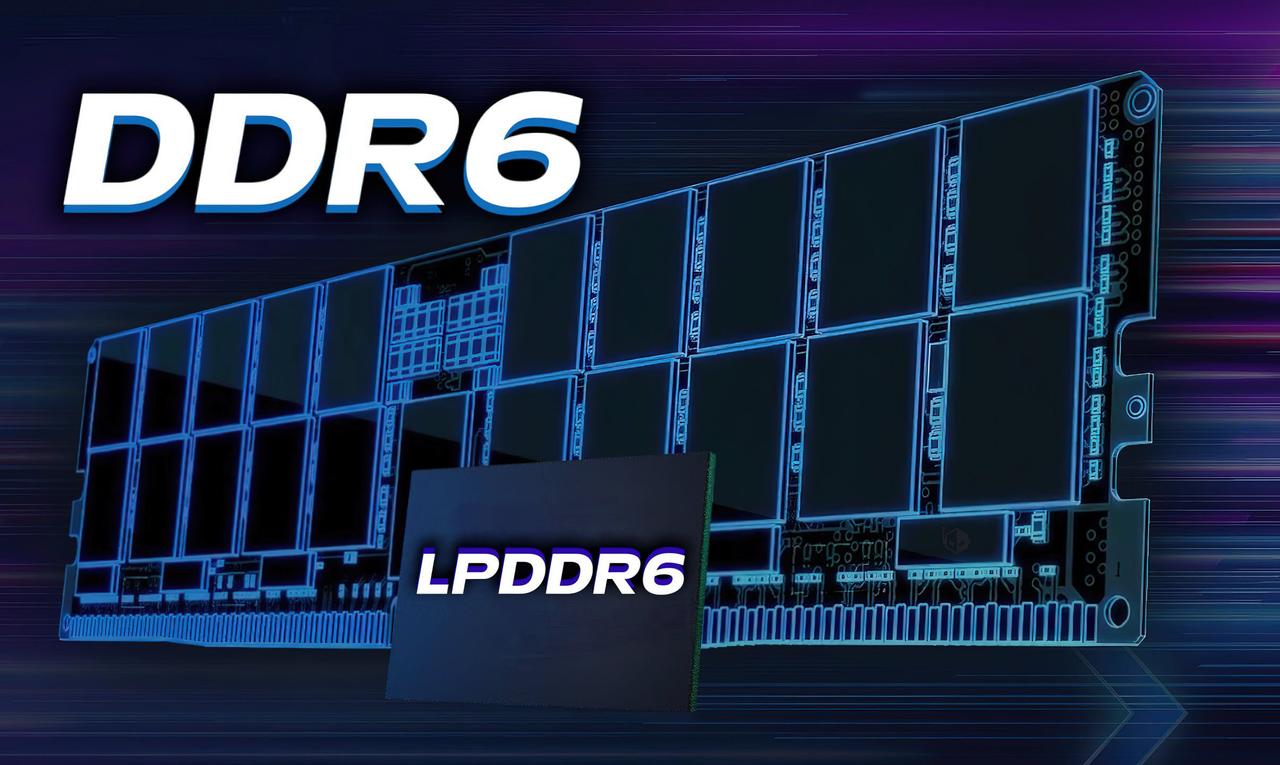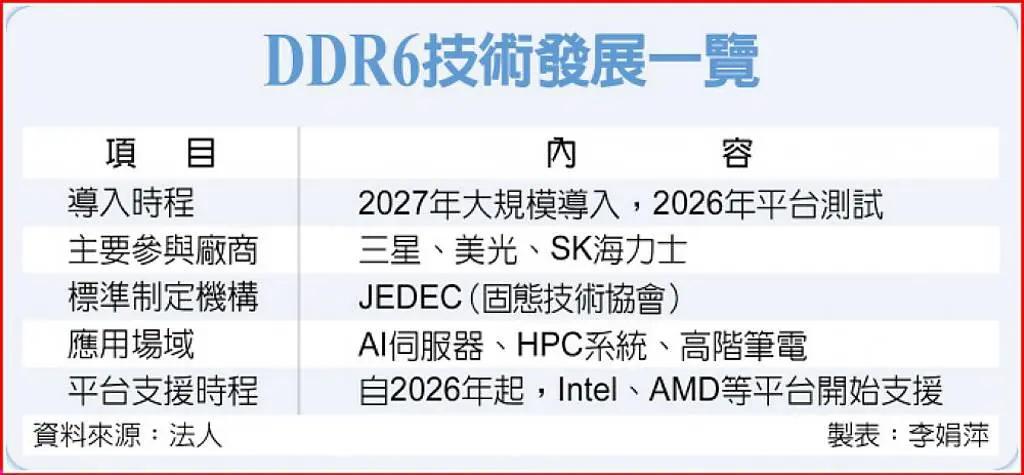DDR6 Memory: Next-Gen Standard Set to Double DDR5 Speeds by 2027
3 Sources
3 Sources
[1]
Blazing fast DDR6 memory with 17,600 MT/s speeds on track to launch in 2027
Serving tech enthusiasts for over 25 years. TechSpot means tech analysis and advice you can trust. Something to look forward to: The next generation of PC memory is already in the works. With DDR6 expected to arrive in 2027, major chipmakers are laying the groundwork for faster, more efficient systems - raising the bar once again for everything from gaming rigs to AI workloads. The DDR6 standard, drafted in late 2024, is slated for commercial debut in 2027. According to Taiwanese trade publication Commercial Times, Samsung, Micron, and SK Hynix are on track with prototype designs and are now shifting focus to controller development. The companies are also reportedly working with Intel and AMD on interface testing, with platform validation expected to begin next year. Both major x86 chipmakers plan to support DDR6 in their next-generation CPUs, paving the way for widespread adoption in AI servers, HPC systems, and high-end laptops. According to industry insiders, DDR6 will introduce substantial architectural upgrades over DDR5, with default speeds starting at 8,800 MT/s and scaling up to 17,600 MT/s - twice the official limit of current DDR5. Some reports suggest overclocked modules could eventually reach speeds as high as 21,000 MT/s. Another key upgrade in DDR6 is its multi-channel architecture, which features four 24-bit sub-channels. This design improves parallel processing, data flow, and bandwidth efficiency compared to DDR5's dual 32-bit layout. However, it also places greater demands on module I/O design and signal integrity. Memory manufacturers are positioning CAMM2 as a key form factor for DDR6, especially in laptops and other compact devices. The new module design promises better performance, higher capacity, and improved efficiency compared to traditional DIMMs and SO-DIMMs. Asus and G.Skill recently showcased a 64GB CAMM2 module running at DDR5-10000 speeds, highlighting the format's potential. Following the release of the DDR6 draft, the Joint Electron Device Engineering Council published the final LPDDR6 draft earlier this month, enabling semiconductor firms, memory manufacturers, and chip designers to begin testing and validation under a unified framework. South Korean media outlet The Guru reports that Qualcomm, MediaTek, and Synopsys are already developing LPDDR6 support for their hardware, while Samsung and SK Hynix - having worked on the standard for years - plan to begin mass production of LPDDR6 modules by year's end.
[2]
Samsung, Micron & SK Hynix: DDR6 Development Plans Arrives in 2027 with 8,800-17,600 MT/s Speeds
DDR6 memory is on the horizon, set to transform how systems handle high‑volume data workloads. As AI models grow more complex and data centers demand ever-greater efficiency, the existing DDR5 standard is approaching its practical limits. Traditional DIMM slot designs, with 288 pins and a 2×32‑bit channel structure, encounter issues like signal reflection, crosstalk and impedance mismatches at speeds above 6,400 MT/s. DDR6 addresses these challenges by adopting a 4×24‑bit sub‑channel layout, which distributes data transfer across four narrower channels. This design reduces per‑channel loading and improves signal integrity, ultimately doubling or tripling maximum throughput compared to DDR5. Data rates for DDR6 will launch at 8,800 MT/s, with developmental roadmaps targeting up to 17,600 MT/s. These speeds are critical for applications that rely on rapid memory access -- most notably large‑scale AI training, real‑time inference servers and HPC clusters performing scientific simulations. The new standard not only delivers raw performance gains but also enhances power efficiency. By optimizing data lane usage and improving signaling techniques, DDR6 modules consume less power per bit transferred, helping data centers manage cooling and energy costs more effectively. Physical packaging and module form factors have evolved in tandem with JEDEC's DDR6 specifications. The Compression Attached Memory Module 2 (CAMM2) form factor, standardized by JEDEC and pioneered in Dell systems, replaces traditional socketed DIMMs with a low‑profile, high‑density connector. CAMM2 modules have a thinner design and lower impedance interconnect, enabling motherboard manufacturers to route signals more cleanly and support higher channel counts. This shift also frees up board space, allowing for more flexible system layouts and potentially higher memory capacities per server node. JEDEC completed the initial DDR6 specification draft at the end of 2024, and the LPDDR6 draft appeared in Q2 2025. The industry now moves into platform testing and verification, working closely with leading CPU vendors Intel and AMD. Processor architectures launching in 2026 are expected to natively support DDR6, ensuring that new desktops, workstations and servers can leverage the standard from day one. Memory makers Samsung, Micron and SK Hynix have already fabricated prototype DDR6 chips and are collaborating on controller interoperability tests, validating signal integrity, timing parameters and thermal profiles. On the ecosystem side, motherboard and module vendors are developing reference designs for CAMM2 slots, thermal solutions and packaging processes. Innovations include advanced substrate materials to manage heat dissipation at high data rates, and signal conditioning techniques like on‑die termination and adaptive equalization. These advancements will be critical as memory channel counts increase, since adding more channels compounds challenges in trace length matching and crosstalk control. For enterprises planning future IT deployments, DDR6 represents a strategic opportunity. By integrating next‑generation memory technology, organizations can support larger AI models, reduce latency in data analytics pipelines and accelerate time‑to‑insight for compute‑intensive workloads. Early adopters in hyperscale cloud environments and research institutions will likely gain competitive advantages through lower total cost of ownership (TCO), as DDR6 modules deliver both higher performance and improved energy efficiency. As the industry prepares for a large‑scale roll‑out in 2027, hardware designers and IT architects should begin evaluating DDR6-based platforms now. Key considerations include verifying platform readiness for CAMM2 modules, ensuring BIOS and firmware support for new timing configurations, and validating thermal management strategies for densely populated DIMM slots. Collaborating with memory vendors on qualification testing can help smooth the transition and mitigate early‑adopter risks.
[3]
DDR6 Memory Development Speeds Up With Motherboard & Module Makers Working On New Designs Including CAMM2, Eying A 2027 Release Window With 8800 MT/s Base, And 17,600 MT/s Max Speeds
The development of the next-gen DDR6 memory standard has picked up the pace as various module & motherboard makers are actively working on their solutions. JEDEC finalized the specifications for DDR6 memory in 2024, and so far, we have seen various memory manufacturers developing the next-generation standard. Although the memory will not be available on mainstream platforms for a few years, CTEE reports that the growing demand with in the HPC space has led DRAM makers to accelerate the development process of the new standard. As per the report, all major vendors including Samsung, Micron, and SK Hynix, are speeding up their work on DDR6 memory. With the current pace, the platform testing and verification process will be finished by 2026, and the first application of DDR6 will begin in 2027 when next-gen servers hit the market. It is said that AMD, Intel, and even NVIDIA, are working with DRAM makers to get DDR6 out as early as possible. In terms of what to expect from DDR6 memory, the new standard will have a base transfer rate of 8800 MT/s, an 83% increase over DDR5's 4800 MT/s base speed. 8800 MT/s is already considered really fast for DDR5 memory so starting right there will be a huge deal. As for the top speeds, DDR6 memory will be able to hit up to 17,600 MT/s speeds, a good 70-80% uplift versus today's top-rated DDR5 modules. The DDR6 generation will also see a new architecture design, moving to a 4x24-bit channel versus the 2x32-bit channel for DDR5. Now as far as adoption goes, HPC and AI will be the first market as mentioned above. These platforms will stick close to the JEDEC specs, and it will be sometime before DDR6 memory hits its full potential. DDR5 memory has been out since 2021 but only now have we started to see speeds going beyond 8000-9000 MT/s. Another interesting thing mentioned is that DDR6 memory will require a new slot design to retain signal quality, and ensure high-bandwidth in a high-density/low-impedance design. For this purpose. CAMM2 is being seen as the game-changer. CAMM2's adoption has been slow, both in server and consumer space, but with DDR6, we might finally see the new form factor gain more traction. It is also stated that certain high-end notebooks might utilize DDR6 solutions, and would be based on next-gen CPUs from Intel and AMD. This hints a consumer-centric product but it might as well be related to LPDDR6 since mobile CPUs make sense with low-power memory solutions. It took DDR5 memory a couple of years, and a proper/optimized ecosystem to see mass adoption so the same should be expected for DDR6. Sure the higher speeds will captivate enthusiasts but mainstream success is only seen if there's mass adoption from the consumer space. And just like DDR5, DDR6 will be priced quite high in the first few years.
Share
Share
Copy Link
Major chipmakers are developing DDR6 memory, promising speeds up to 17,600 MT/s and improved efficiency for AI and HPC applications. The new standard is expected to launch in 2027, with CAMM2 as a key form factor.
DDR6: The Next Leap in Memory Technology
The next generation of computer memory, DDR6, is on the horizon, promising a significant leap in performance and efficiency. Major chipmakers Samsung, Micron, and SK Hynix are accelerating development, with the new standard expected to debut commercially in 2027
1
2
3
.Unprecedented Speeds and Efficiency
DDR6 is set to double the speeds of its predecessor, DDR5. The new standard will start at a base transfer rate of 8,800 MT/s, with the potential to reach up to 17,600 MT/s
1
3
. This substantial increase in speed is crucial for handling high-volume data workloads, particularly in AI training, real-time inference servers, and HPC clusters2
.
Source: Wccftech
The improved performance doesn't come at the cost of efficiency. DDR6 is designed to optimize power consumption, featuring enhanced data lane usage and improved signaling techniques. This advancement is expected to help data centers manage cooling and energy costs more effectively
2
.Architectural Innovations
A key upgrade in DDR6 is its multi-channel architecture, featuring four 24-bit sub-channels. This design improves parallel processing, data flow, and bandwidth efficiency compared to DDR5's dual 32-bit layout
1
2
. The new architecture addresses challenges like signal reflection, crosstalk, and impedance mismatches that current DDR5 standards face at higher speeds2
.CAMM2: A Game-Changing Form Factor
The Compression Attached Memory Module 2 (CAMM2) is positioned as a key form factor for DDR6, especially in laptops and other compact devices
1
3
. CAMM2 replaces traditional socketed DIMMs with a low-profile, high-density connector, offering better performance, higher capacity, and improved efficiency2
.Industry Collaboration and Development
Major players in the tech industry are collaborating to bring DDR6 to market. Intel and AMD are working with memory manufacturers on interface testing and platform validation
1
. Qualcomm, MediaTek, and Synopsys are developing LPDDR6 support for their hardware1
.Related Stories
Impact on AI and High-Performance Computing
The advent of DDR6 is particularly significant for AI and high-performance computing applications. The increased speeds and efficiency will support larger AI models, reduce latency in data analytics pipelines, and accelerate compute-intensive workloads
2
. This advancement is expected to provide early adopters in hyperscale cloud environments and research institutions with competitive advantages through improved performance and lower total cost of ownership2
.
Source: Guru3D
Looking Ahead
As the industry prepares for the large-scale rollout of DDR6 in 2027, hardware designers and IT architects are advised to begin evaluating DDR6-based platforms. Key considerations include verifying platform readiness for CAMM2 modules, ensuring BIOS and firmware support for new timing configurations, and validating thermal management strategies
2
3
.While DDR6 promises significant advancements, it's worth noting that, like its predecessors, it may take a couple of years and a properly optimized ecosystem to see mass adoption in the consumer space
3
.References
Summarized by
Navi
[2]
Related Stories
JEDEC Unveils LPDDR6 Memory Standard: Boosting Performance and Efficiency for AI and Mobile Devices
10 Jul 2025•Technology

Micron Unveils Ultra-Fast DDR5 Memory Modules for AI PCs, Doubling Speed of DDR4
16 Oct 2024•Technology

SK Hynix Develops Industry-First 16GB DDR5 Memory Using 1c Node on 10nm Process
29 Aug 2024

Recent Highlights
1
OpenAI releases GPT-5.2 AI model after code red memo signals Google Gemini 3 threat
Technology

2
Disney invests $1 billion in OpenAI, licenses 200+ characters for Sora AI video generator
Technology

3
OpenAI faces wrongful death lawsuit after ChatGPT allegedly fueled murder-suicide tragedy
Policy and Regulation





